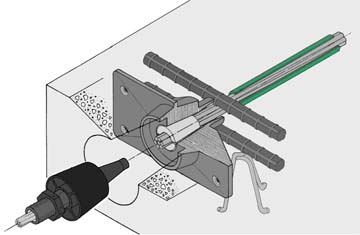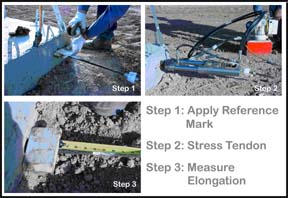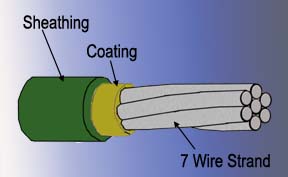|
|
|
|
|
|
|
|
|
|||
|
|
|
|
||||||||
|
What Materials and Equipment are used in Post-Tensioning? The basic element of a post-tensioning system is called a tendon. A post-tensioning tendon is made up of one or more pieces of prestressing steel, coated with a protective coating, and housed inside of a duct or sheathing. A tendon will have anchors on each end to transmit the forces into the structure. Long tendons may also have intermediate anchors along their length. The prestressing steel can be a high strength steel strand (typical in horizontal applications) or a high strength steel bar (typical in vertical applications). Prestressing steel is manufactured to applicable ASTM requirements. Typical strand sizes are 0.50 in. and 0.60 in. diameters, and bar sizes can typically range from 1 in. to 2.5 in. To get an idea of the high strength of this type of steel, a typical steel strand used for post-tensioning will yield at about 243,000 psi. In comparison, a typical piece of rebar will yield at about 60,000 psi.
Tension is applied to prestressing steel by using a hydraulic stressing jack. The jack bears against one of the anchors that is embedded in the concrete and pulls the steel to a predetermined force. As the tensioning is occurring, the steel is being elongated, and the concrete or masonry element is being compressed. When the proper tensioning force is reached, the prestressing steel is anchored in place. The anchors are designed to provide a permanent mechanical connection, forever keeping the steel in tension, and the concrete in compression.
|
Source: PT Concrete.com
||||||||||
|
Home
| Company |
Products |
Services
| Support |
News |
Contact
Us © Copyright 2008 SPECIALTY STEEL rebar & post tension foundations |
||||||||||


 The
duct or sheathing that houses the prestressing steel provides one layer of
corrosion protection. A tendon with a duct that contains multiple pieces of
prestressing steel strand is commonly called a
The
duct or sheathing that houses the prestressing steel provides one layer of
corrosion protection. A tendon with a duct that contains multiple pieces of
prestressing steel strand is commonly called a